Burglar Alarm
A system that alerts homeowners or business owners to an intruder via annunciators and sensors. A burglar alarm system is activated and deactivated by the user via a smartphone, keyfob, control panel or keypad.
Are you at risk for a burglary?
The unfortunate answer is yes – we are all at risk. In 2016, 1,515,096 burglary offenses were committed in our country according to the 2016 FBI Uniform Crime Report with a burglary occurring every 20 seconds in 2015. 2016 Losses due to burglary totaled an estimated $3.6 billion; overall, the average dollar loss per burglary offense was $2,361. For more FBI Uniform Crime statistics visit the FBI site
Security systems do work
The good news is you can fight off these intruders with the installation of a professionally monitored electronic security system. In a 2013 UNC Charlotte study, Approximately 83 percent (of the more than 400 convicted offenders surveyed) said they would try to determine if an alarm was present before attempting a burglary, and 60 percent said they would seek an alternative target if there was an alarm on-site.
Scroll Down to Learn All About the Parts of the System
Tips From Convicted Burglars
A video released by the Columbus Division of Police and the Ohio Department of Rehabilitation and Correction features three convicted burglars offering tips to help homeowners secure and protect their homes
From the Big House to Your House – Part 1
From the Big House to Your House – Part 2
An alarm system is made up of the following parts:
- control panel, the “brain” or central processing unit of the system;
- keypads, allow the user to activate or deactivate the system and check the system via a visual display;
- sensors, detect activity within the system; and
- an annunciator, bells, sirens or lights that sound or display when the sensors detect activity within the system.
Burglar Alarm Demonstration
Click on the Play button to view how an alarm works
Control Panel
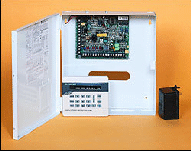 The control panel is the “brain” of the alarm system. When a detection device of any kind is activated the signal is transmitted to the control panel, which in turn activates the audible sounding device, and the communicator, (if the system has one) to report the alarm.
The control panel is the “brain” of the alarm system. When a detection device of any kind is activated the signal is transmitted to the control panel, which in turn activates the audible sounding device, and the communicator, (if the system has one) to report the alarm.
The control panel turns the system on and off via remote arming stations.
It also includes the alarm system’s power supply and standby battery.
Monitoring
NESA strongly advocates having your system professionally monitored. In the event of the alarm being triggered the 24-hour monitoring station is contacted via the system. The monitoring station immediately summons help from the police or fire departments. If a system is not linked to a monitoring station no help will be called in the event you are away from home or if you are home and unable to call for help.
 Digital Communicators are the most common method used in homes to transmit an alarm signal from the home over regular telephone wires to an alarm monitoring station. When the alarm is activated the digital communicator seizes the telephone line and dials the central station computer, confirms contact and delivers a coded signal giving the location and type of alarm that has been activated. The service should call your home and ask for your password to determine if a burglar alarm was unintentional. If you provide the correct password and state that the alarm was unintentional, they should not call the police. If you give an incorrect password, they should dispatch the police based on a possible hostage situation. If the monitoring service calls and receives a busy signal, an answering machine, or if no one answers the phone, they should dispatch the police.
Digital Communicators are the most common method used in homes to transmit an alarm signal from the home over regular telephone wires to an alarm monitoring station. When the alarm is activated the digital communicator seizes the telephone line and dials the central station computer, confirms contact and delivers a coded signal giving the location and type of alarm that has been activated. The service should call your home and ask for your password to determine if a burglar alarm was unintentional. If you provide the correct password and state that the alarm was unintentional, they should not call the police. If you give an incorrect password, they should dispatch the police based on a possible hostage situation. If the monitoring service calls and receives a busy signal, an answering machine, or if no one answers the phone, they should dispatch the police.
Some important issues in selecting monitoring services are:
- UL Listed: A UL listed monitoring service is required to maintain the highest industry standard for its premises, equipment, and operations. This is based on Underwriters Laboratories’ independent, objective standards, which it enforces through its rules and regulations, including regular and surprise visits, tests and inspections.
- Back-Up Systems: The monitoring service should have a complete back-up system that includes duplicated computer systems, power generator, and an alternate routing into the nation’s telecommunication grid.
- Location Is Unimportant: Some consumers wrongly perceive that a local monitoring facility is better than one out-of-town. The fact is, the quality of the monitoring service is the important issue. With the sophistication of the current telecommunications network, there is about a one-second difference between connecting with an out-of-town versus local telephone number. In fact, a local service may not have the financial resources of a larger out-of-town service; consequently, their equipment may be of lesser quality and result in a longer response time than the out-of-town service.
- In-House Versus Third Party Monitoring: A security company may perform the monitoring themselves in-house or may contract to have a third party perform the monitoring. There’s no inherent advantage to either method. You can receive great or inferior monitoring with either in-house or third party methods.
Arming Stations
Key operated arming stations use a high security key to arm and disarm the system, A red light is normally used to indicate if the system is armed. A more common type of arming station is the digital key pad. This is much like the key pad on a touch-tone telephone. A preset combination number is entered into the key pad to arm and disarm the system. The combination code can be changed.
Some systems may be controlled with “key fobs” that can be carried on a key chain. Buttons on the fob are used to turn the system on and off.
Types of Keypads:
- L-E-D: divides your building into numbered areas or zones and uses a light blinking next to the numbered zone to indicate the location of a problem. The keypad may emit an audible beep to confirm that keys are pressed and a louder siren type noise when an alarm is activated.
- L-C-D Fixed Language: divides your building into numbered zones and uses an alpha numeric display to indicate the location of a problem. A limited number of pre-selected words are used for the descriptions. The keypad may emit an audible beep to confirm that keys are pressed and a louder siren type noise when an alarm is activated.
- Fixed Talking: divides your building into numbered areas or zones and a voice is used to indicate the location of a problem. The voice is pre-recorded with a limited number of words. It does not use your voice or choice of words. The keypad may emit an audible beep to confirm that keys are pressed and a louder siren type noise when an alarm is activated.
- L-C-D Programmable Language: divides your building into numbered areas or zones and uses user selected words such as den or back French doors to name the zones. An alpha numeric display is used to indicate the location of a problem. The keypad may emit an audible beep to confirm that keys are pressed and a louder siren type noise when an alarm is activated.
When Do You Use The Keypad?
The keypad is the part of the system that you will use on a daily basis. Some of the ways that you will use the keypad, include:
- Turn System On/Off: All keypads are used to turn the system on and off. You select a function and enter your personal code to validate the entry. Some keypads allow you to assign a temporary code to a guest or baby-sitter and then delete the temporary code once it is no longer needed.
- Help In A Panic Situation: Most keypads have a panic button or panic key sequence that will immediately activate the alarm and alert the monitoring service. The panic button will function regardless of whether the system is on or off. It’s the quickest and simplest method of calling for help.
- Alert Police You’re A Hostage: Some keypads allow the use of a hostage or duress code. For example, if you are being held against your will, and the intruder orders you to deactivate the alarm system, you can enter your hostage code rather than your normal code. The system deceives the intruder by indicating that you have followed his instruction and deactivated the system while, in fact, a silent alarm is sent to the monitoring service. The monitoring service will not call to verify that you need help; they assume you’re in a hostage situation and immediately notify the police.
Features Of Keypads
The features vary by the type of keypad. Following are a few of the more popular and important features.
- Controlling Household Lights: To turn on selected lights when you enter the house and or to automatically turn on the lights when the alarm is activated.
- Lighted Display: Some LCD keypads have a lighted display and lighted number keys. This is not only a matter of convenience but also an important safety feature in an emergency situation. You will be able to quickly find the keypad and easily read the display at night when the lights are off.
- Prompting Assistance: Some of the alpha numeric and talking keypads use prompts to help you in working with the keypad. For example, if you want to create a temporary code for the baby-sitter, the keypad will provide work prompts to take you through the process step by step.
Annunciators
- Bells, sirens or lights sound or display when the sensors detect activity within the system.
 Siren– An electronic output alarm device designed to produce a very loud, hard to ignore sound when activated. Sirens are available in many shapes and sizes. They can be concealed or mounted in plain sight.
Siren– An electronic output alarm device designed to produce a very loud, hard to ignore sound when activated. Sirens are available in many shapes and sizes. They can be concealed or mounted in plain sight. Bell – Electromechanical device noise-making device. A clapper is moved electromechanically to strike the bell and produce a loud ringing sound.
Bell – Electromechanical device noise-making device. A clapper is moved electromechanically to strike the bell and produce a loud ringing sound.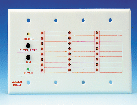 Annunciator- A visual indicator showing the location of an alarm. Annunciators pinpoint the exact location of an alarm or problem. With their help, the alarm user can locate a faulted door or sensor at closing time. In addition, service personnel can quickly locate a system defect. Many keypad also contain lights or displays to annunciate system events.
Annunciator- A visual indicator showing the location of an alarm. Annunciators pinpoint the exact location of an alarm or problem. With their help, the alarm user can locate a faulted door or sensor at closing time. In addition, service personnel can quickly locate a system defect. Many keypad also contain lights or displays to annunciate system events.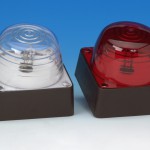 Strobe – Strobe light can be used to visually indicate an alarm condition. Various color lens can be used to differentiate separate events. Strobe lights usually flash to save power and attract more attention. Strobe lights can help authorities locate the site of an alarm.
Strobe – Strobe light can be used to visually indicate an alarm condition. Various color lens can be used to differentiate separate events. Strobe lights usually flash to save power and attract more attention. Strobe lights can help authorities locate the site of an alarm.
Perimeter Sensors
Listed below are different types of sensors used in an alarm system. Discuss with your alarm professional what is best for your system. Use varies depending on the space covered, whether there are small children or pets in the household, what the system is protecting for instance specific valuable objects, etc. Sensors installed on doors, windows and other outside openings are called perimeter protection. Area/space protection is when sensors are installed inside a home or business.
Magnetic Contacts
 Magnetic contacts are used to sense when a door or window has been opened.
Magnetic contacts are used to sense when a door or window has been opened.
Contacts can be surface mounted on a door or window or flush mounted so that they are concealed when the door or window is closed.
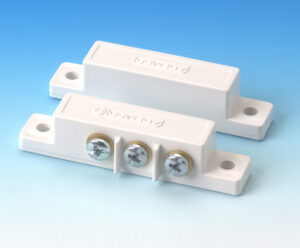 They depend on the direct physical operation/disturbance of the sensor to generate an alarm. Magnetic switches are composed of two parts – a two-position magnetic switch mounted on the interior of a door, window or container frame, and a two-position, magnetically operated switch. The standard switch is designed to be either normally open or normally closed, depending on the design. When the door or window is closed, the magnet pulls the switch to its “normal” non-alarmed position. When the door or window is opened, the magnet releases the switch, breaking the contact and activating the alarm.
They depend on the direct physical operation/disturbance of the sensor to generate an alarm. Magnetic switches are composed of two parts – a two-position magnetic switch mounted on the interior of a door, window or container frame, and a two-position, magnetically operated switch. The standard switch is designed to be either normally open or normally closed, depending on the design. When the door or window is closed, the magnet pulls the switch to its “normal” non-alarmed position. When the door or window is opened, the magnet releases the switch, breaking the contact and activating the alarm.
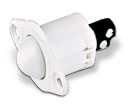 Mechanical Switches Plunger switch
Mechanical Switches Plunger switch
Mechanical switches are used to detect the opening of a protected door or window. These sensors are contact switches that depend on direct physical operation or disturbance of the sensor to generate an alarm. Mechanical switches are spring-loaded or plunger devices that trigger when a door or window is opened.
Glass Break Detectors
These devices sense the vibration or sound of breaking glass in a window or a door and activate the alarm. Some sensors are mounted directly on the window glass others are mounted in the room where the windows are located.
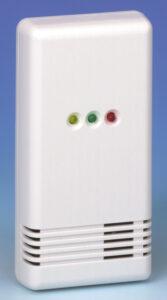 Acoustic sensors listen for, and detect, the high frequency typically created when an initial shattering impact is made on the window. Once impact is made, high frequencies caused by the glass breaking travel away from the point of impact toward the outer edges of the glass surface. These vibrations excite the acoustic sensor processor which passes the frequency through a filter, compares the frequency for a match and signals an alarm if appropriate.
Acoustic sensors listen for, and detect, the high frequency typically created when an initial shattering impact is made on the window. Once impact is made, high frequencies caused by the glass breaking travel away from the point of impact toward the outer edges of the glass surface. These vibrations excite the acoustic sensor processor which passes the frequency through a filter, compares the frequency for a match and signals an alarm if appropriate.
Glassbreak sensors monitor glass that is likely to be broken during intrusion. The sensors are housed in a single unit and mounted on a stable interior element (wall or ceiling) facing the main glass surface. Shock sensors feel/sense the typical frequency shock wave that is created when glass is broken. When the processor detects this shock it signals an alarm.
 Dual Technology Acoustic/Shock Glassbreak Sensors monitor glass that is likely to be broken during intrusion. The sensors are housed in a single unit and mounted on a stable interior element (wall or ceiling) facing the main glass surface. In dual-tech sensors an acoustic device is linked with a shock device. This combination utilizes the complementary capabilities of both Audio Shock devices and provides for a low false alarm rate sensor. The acoustic portion of the sensor uses a microphone to detect frequencies associated with breaking glass. A processor filters out all unwanted frequencies and only allows frequencies at certain ranges to be analyzed. Once the processor receives the frequency, it is compared to those associated with glass breakage. If the signal matches frequencies characteristic of breaking glass, then a signal is sent to the AND gate. The shock portion of the sensor “feels” for the frequency in the form of a shock wave created when glass is broken. When the processor detects this shock, it sends a signal to the AND gate. Once the AND gate has received both signals an alarm is generated.
Dual Technology Acoustic/Shock Glassbreak Sensors monitor glass that is likely to be broken during intrusion. The sensors are housed in a single unit and mounted on a stable interior element (wall or ceiling) facing the main glass surface. In dual-tech sensors an acoustic device is linked with a shock device. This combination utilizes the complementary capabilities of both Audio Shock devices and provides for a low false alarm rate sensor. The acoustic portion of the sensor uses a microphone to detect frequencies associated with breaking glass. A processor filters out all unwanted frequencies and only allows frequencies at certain ranges to be analyzed. Once the processor receives the frequency, it is compared to those associated with glass breakage. If the signal matches frequencies characteristic of breaking glass, then a signal is sent to the AND gate. The shock portion of the sensor “feels” for the frequency in the form of a shock wave created when glass is broken. When the processor detects this shock, it sends a signal to the AND gate. Once the AND gate has received both signals an alarm is generated.
Wired Screens
 Specially designed window screens can be installed with laced wire. These screens contain inconspicuous, built-in alarm wire which protects against cutting or tearing the screen, and also contain a magnetic contact to guard against removal of the screen.
Specially designed window screens can be installed with laced wire. These screens contain inconspicuous, built-in alarm wire which protects against cutting or tearing the screen, and also contain a magnetic contact to guard against removal of the screen.
When the wire is cut the alarm’s annunciator will signal a break in security.
Screens allow you to activate the alarm system while a window is open.
Interior Motion Sensors
Passive infrared, photoelectric, ultrasonic, or microwave detectors sense changes in a room caused by a human presence.
Passive Infrared Detector 
Passive Infrared Detectors can be used to sense the entry of an intruder into an area. They can be mounted on the wall or ceiling and can be set to cover rooms of various sizes. Flush mounted or disguised sensors are also available. Some detectors have features designed to minimize activation by small pets.
Passive Infrared (PIR) sensors are passive, that is, the sensor does not transmit a signal; the sensor head simply registers an impulse when received. The sensor head is typically divided into several sectors/zones, each defined with specific boundaries. Detection occurs when an emitting heat source (thermal energy) crosses a sector boundary. Passive infrared sensors detect electromagnetic radiated energy generated by sources that produce temperatures below that of visible light. PIR sensors do not measure the amount of IR energy per se, but rather the change of thermal radiation. PIRs “see/detect” infrared “hot” images by sensing the contrast between the “hot” image and the “cooler” background. The PIR wavelength is subdivided into two major range detection categories: one covers Near Infrared Energy (e.g. thermal energy emitted by TV remote control devices), and the other covers the Far Infrared Energy (e.g. thermal energy emitted by people). It is this latter category which is employed in security applications. Infrared energy is measured in microns, with the human body producing energy in the region of 7-14 microns. Most PIR sensors are focused on this narrow band width. When the radiation change captured by the PIR exceeds a certain pre-set value, the thermal sensor produces an electrical signal which is sent to a built-in processor for evaluation and possible alarm.
Photoelectric Detectors
 Photo electric beam sensors transmit a beam of infrared light to a remote receiver creating an “electronic fence”. These sensors are often used to “cover” openings such as doorways or hallways, acting essentially as a trip wire. Once the beam is broken/ interrupted, an alarm signal is generated. Photoelectric beam sensors consist of two components: a transmitter and a receiver. The transmitter uses a Light Emitting Diode (LED) as a light source and transmits a consistent infrared beam of light to a receiver. The receiver consists of a photoelectric cell that detects when the beam is present. If the photoelectric cell fails to receive at least 90% of the transmitted signal for as brief as 75 milliseconds (time of an intruder crossing the beam), an alarm signal is generated. The beam is modulated at a very high frequency which changes up to 1,000 times per second in a pattern that correlates with the receiver’s expectation to guard against a bypass attempt by using a substitute light source. In order to bypass the sensor, the angle of the beam and modulation frequency would have to be matched perfectly.
Photo electric beam sensors transmit a beam of infrared light to a remote receiver creating an “electronic fence”. These sensors are often used to “cover” openings such as doorways or hallways, acting essentially as a trip wire. Once the beam is broken/ interrupted, an alarm signal is generated. Photoelectric beam sensors consist of two components: a transmitter and a receiver. The transmitter uses a Light Emitting Diode (LED) as a light source and transmits a consistent infrared beam of light to a receiver. The receiver consists of a photoelectric cell that detects when the beam is present. If the photoelectric cell fails to receive at least 90% of the transmitted signal for as brief as 75 milliseconds (time of an intruder crossing the beam), an alarm signal is generated. The beam is modulated at a very high frequency which changes up to 1,000 times per second in a pattern that correlates with the receiver’s expectation to guard against a bypass attempt by using a substitute light source. In order to bypass the sensor, the angle of the beam and modulation frequency would have to be matched perfectly.
Ultrasonic Detectors
The Active Ultrasonic sensor is a motion detecting device that emits ultrasonic sound energy into a monitored area and reacts to a change in the reflected energy pattern. Ultrasonic sensors use a technique based on a frequency shift in reflected energy to detect intruders. Ultrasonic sound is transmitted from the device in the form of energy. The sound uses air as its medium and travels in a wave type motion. The wave is reflected back from the surroundings in the room/hallway and the device “hears” a pitch characteristic of the protected environment. When an intruder enters the room, the wave pattern is disturbed and reflected back more quickly, thus increasing the pitch and signaling an alarm.
 Microwave Detectors
Microwave Detectors
Microwave sensors are motion detection devices that transmit/flood a designated area/zone with an electronic field. A movement in the zone disturbs the field and sets off an alarm. Microwave Sensors may be used in exterior and interior applications. Although very little power is used, the system provides enough energy for a detector to project a signal up to 400 feet in an uninterrupted line of sight. The detection of intrusion is directly related to the Doppler frequency shift principle. Most sensors are tuned to measure the Doppler shift between 20 Hz and 120 Hz. These frequencies are closely related to the movements of humans. Objects that fail to produce a signal or produce a signal outside the tuned frequencies are ignored. Objects that fall within the range cause the sensor to generate an alarm signal.
Microwave sensors can be used to monitor both exterior areas and interior confined spaces, such as vaults, special storage areas, hallways and service passageways. In the exterior setting they can be used to monitor an area or a definitive perimeter line, as well as to serve as an early warning alert of intruders approaching a door or wall.
Dual Technology Detectors
 Dual-Technology Passive Infrared/Microwave sensors use a combination of both microwave and passive infrared technology in combination with AND logic to provide a lower False Alarm Rate (FAR) sensor than either of the sensors independently. This category of sensors are typically referred to as Dual-Tech. In this type Dual-Technology sensor, a passive sensor (PIR) and an active sensor (Microwave or Ultrasonic) are combined into one unit. Both sensing elements are located in a single casing, and are connected electronically by using the AND Logic function. The areas of coverage for each sensor are similar in shape so the detection zone is uniform. Since the two sensors will not “sense” an intrusion detection precisely at the same instant, the system is designed to generate an alarm when both sensors produce an output in a pre-selected time interval.
Dual-Technology Passive Infrared/Microwave sensors use a combination of both microwave and passive infrared technology in combination with AND logic to provide a lower False Alarm Rate (FAR) sensor than either of the sensors independently. This category of sensors are typically referred to as Dual-Tech. In this type Dual-Technology sensor, a passive sensor (PIR) and an active sensor (Microwave or Ultrasonic) are combined into one unit. Both sensing elements are located in a single casing, and are connected electronically by using the AND Logic function. The areas of coverage for each sensor are similar in shape so the detection zone is uniform. Since the two sensors will not “sense” an intrusion detection precisely at the same instant, the system is designed to generate an alarm when both sensors produce an output in a pre-selected time interval.
Audio detectors
 Audio detectors listen for noises generated by an intruder’s entry into a protected area, and are generally used, but not exclusively, in internal applications, from an entrance foyer to critical data/resource storage areas. The sensor is made up of two devices: Pick-up units mounted on the walls or ceilings of the monitored area, and an Amplifier unit which includes processing circuitry. The Pick-up units are basically microphones that listen for noise. These microphones collect sound for analysis by the processor circuit, which can be calibrated to a noise threshold that is characteristic for an intrusion attempt. If a certain amount of noise is detected from a monitored area within a selected time period, an alarm signal is generated.
Audio detectors listen for noises generated by an intruder’s entry into a protected area, and are generally used, but not exclusively, in internal applications, from an entrance foyer to critical data/resource storage areas. The sensor is made up of two devices: Pick-up units mounted on the walls or ceilings of the monitored area, and an Amplifier unit which includes processing circuitry. The Pick-up units are basically microphones that listen for noise. These microphones collect sound for analysis by the processor circuit, which can be calibrated to a noise threshold that is characteristic for an intrusion attempt. If a certain amount of noise is detected from a monitored area within a selected time period, an alarm signal is generated.
Wired Versus Wireless?
Systems can be hardwired into a home or business or can be wireleWireless ss. There are pluses and minuses to each.
- A wireless system uses radio frequencies to communicate with the systems components, whereas a wired system is hardwired together via wires from one system component to the next; these wires may be exposed.
- Wireless systems require the maintenance of battery changing but have the convenience of portability if a homeowner decides to move.
- Hardwire parts may be less expensive than wireless; however it may be costly to conceal wires in a hardwired system.
Smoke Detectors
Provide the earliest possible warning of a fire. They should be installed inside and outside of each sleeping area and on each level of your home. Visit our fire alarm guide for more information.
